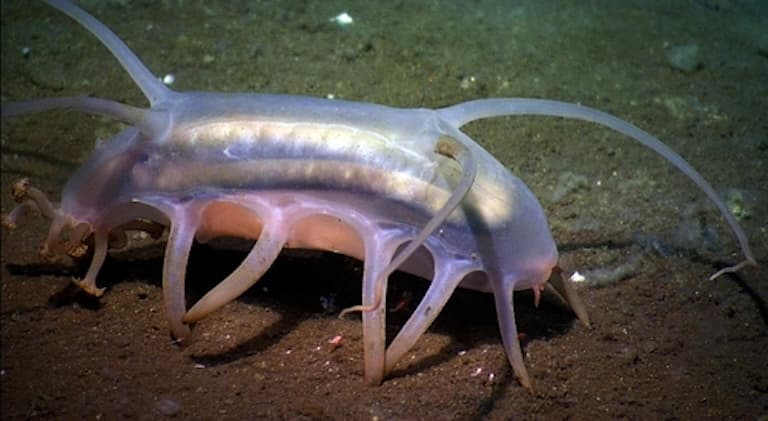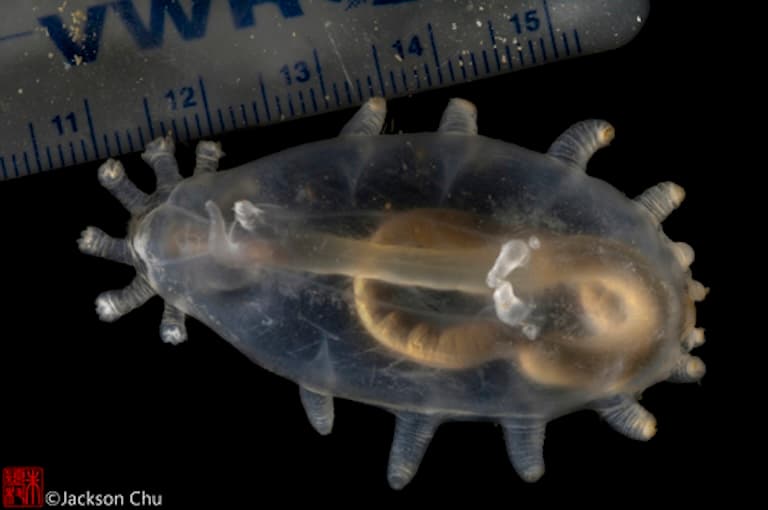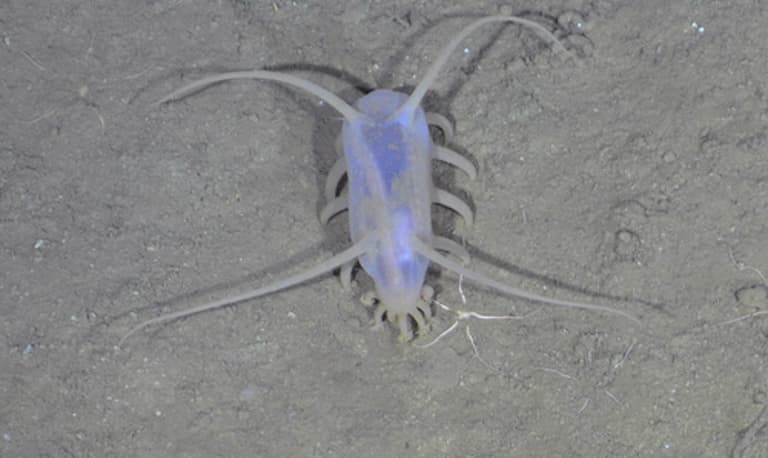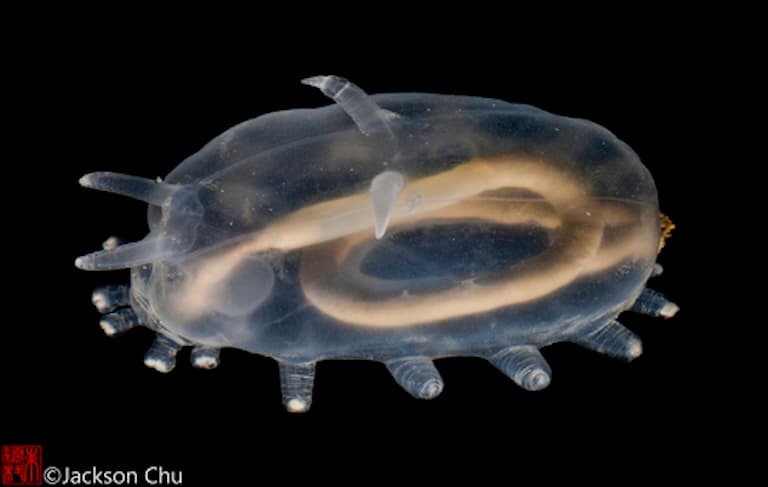Sea Pig Profile
Did King Philip Come Over for Fried Sausages?
This is one of the mnemonics biology nerds use to remember the order of the increasingly branching taxonomic ranks describing all life.
At one end, you have species: organisms that are the most closely related. Species are typically separated by no more than 1 to 3 million years of evolution. At the other end, you have the Domains: the widest nets of life. These separate the Bacteria from the Eukarya (organisms with a cell nucleus), the most distantly related organisms.
Within Domains, the kingdoms categorise everything. Within Eukarya – where we reside – are the pants, animals and fungi, still very distantly related Kingdoms. Within each kingdom, there are Phyla, which in the Animalia kingdom categorises all animals at their most distantly related.
These phyla branched off from one another at the beginning of animal evolution. They are the most distant of cousins that you can find between animals. Sea cucumbers, then, in the phylum Echinodermata are about as far from you and me as you can find, and sea pigs, a genus of sea cucumbers, share a common ancestor with land pigs that existed as far back as 600 million years ago.
This is a phenomenally long time, but then, the common ancestor between sea cucumbers and garden cucumbers was somewhere around 1.6 billion years ago.

Sea Pig Facts Overview
| Habitat: | The Abyssal plane, 1,200 to 5,000 meters (3,900 to 16,400 feet) |
| Location: | Atlantic, Pacific, Indian oceans |
| Lifespan: | Unknown |
| Size: | 4 to 6 inches (10 to 15 centimetres) |
| Weight: | Unkown |
| Colour: | Transparent/white |
| Diet: | Organic matter from the ocean floor |
| Predators: | Unknown, likely crustaceans, squid, other benthic predators |
| Top Speed: | Unknown |
| No. of Species: | 3 |
| Conservation Status: | Not Listed (IUCN) |
Sea pigs are one of the few bilaterally symmetrical echinoderms, which is part of how they get their name.
Their hydraulic tube feet and funny little mouth tentacles give them the ability to snuffle through the dusty detritus at the bottom of the ocean, but their adaptation to these pressures means that their bodies disintegrate when brought to the surface.
As such, they’re hard to study, and better observed in their natural habitats.
Interesting Sea Pig Facts
1. They’re bilaterally symmetrical
You should be, too. Bilateral symmetry basically means you have all your limbs and organs separated and mirrored by a line down the middle. In most cases, you have one arm on each side, one eye, one kidney, nostril, leg and gonad on each side of this line.
Most of the animals you’re familiar with will share this body type, even down the the fly in your soda, but it’s far from the only one that evolved.
Most Echinoderms have radial symmetry. Instead of a line, they have a point, around which all their bits and pieces are mirrored. Think of the starfish and sea urchin, who form circular, or radial body types with multiple limbs and organs around a central focal point.
So, for sea pigs to have bilateral symmetry, like we do, is quite strange! It appears that all echinoderms evolved bilateral symmetry once upon a time and then converted to radial symmetry instead. All except the sea cucumbers. Which makes sea pigs a little bit more like land pigs. 1
2. They’re smaller than ordinary pigs
Unlike their namesakes, sea pigs are diminutive, growing up to a maximum length of around 15 cm. They spend their time on the dusty ocean floor, vacuuming up organic material that descends from above.
The chaos near the surface provides a lot of matter: fish scales, torn flesh, poop, and various other organic components of the brutal shallow world gently sink into the depths, and animals like sea pigs are there for it.
As detritivores, they’re important to the nutrient cycle in the ocean, and while they spend most of their time pottering about on the floor, they can also swim, if encouraged strongly. 2

3. They can stiffen their skin at will
Another thing sea pigs can do that regular pigs can’t is to make their own crackling. Like all sea cucumbers, sea pugs have no shell or skeleton, but they do have some unique tissues known as mutable collagenous tissue, which is similar to the smooth muscle that you’d find in your bladder or gut.
This tissue can be contracted and relaxed and allows the animal to stiffen up their skin when the urge arises, likely as a way of adapting its body to threats. 3
4. They have tube feet
The appendages on this weird jelly-like animal give it the appearance of a sort of twelve-legged pig. These aren’t real feet, but hydraulic tubes that serve multiple purposes.
These tubes are made for walking, and that’s just what they do, but they also appear to be related to respiration, at least in the most frontal tubes, but quite how this works is still a bit of a mystery.
Water cavities within the tubes inflate and deflate in a coordinated fashion to create locomotion, which disturbs the sea bed, kicking up tasty bits of rotting organic matter for the animal to eat. 4

5. And mouth tentacles
Feeding is aided by a set of around ten buccal, or mouth, tentacles which likely act as sensory organs and perhaps help manipulate food into the mouth opening. These sit in a circle around the mouth and the skin on their surface is highly folded, suggesting surface area is important here.
They may aid in gas exchange or function as sensory receptors, or both.
6. They breathe from their butts
The respiratory system in echinoderms is known to be a bit crap. They don’t have lungs, and there’s not a lot to talk about in regards to breathing.
Animals with gills and lungs and so on have a series of branching, subdividing pathways for gases to enter, but there’s no such reparatory tree found in sea pigs.
Their system is so badly designed that they breathe through their anus, which makes you wonder what happens when they fart.
7. They have water for blood
Because they have no skeletons, sea pigs have to work with what they’ve got. Like other soft-bodied animals, they function as a product of muscular contractions, but unlike cephalopods, which mostly use muscular torsion, sea pigs have an entire water-balloon strategy for their biological processes.
Squeezing water at one end creates bulges at the other, and this is basically how all physiological processes occur inside sea pigs.
Their waste processing, transportation, respiration and locomotion are all controlled by this water vascular system, manipulated by muscles squeezing on water-filled cavities.
This system is hard to understand fully, as their delicate bodies are ruptured to a large degree when they’re pulled out of the water.
But even an animal this delicate has some interesting defenses.

8. They have crab friends
Sea pigs have been recorded looking after baby spider crabs, probably as part of a symbiotic relationship in which both animals gain the protection of the other. This relationship was found in 91%-100% of the sea pigs observed, so it’s a very common occurrence.
Being so squishy, it’s of course useful to have a strong, bony set of pincers to deter pests, and the baby crabs, being so small, benefit from the other level of defense found in the sea pig. 5
9. They’re toxic
Sea cucumbers produce a form of neurotoxin called holothurin. They can be excreted through tubes in the skin and are poisonous to many animals, including humans.
This is why it’s dangerous to name deep sea creatures after food, and how the spider crab gets its share of the deal when cohabiting with the sea pig. 6
Sea Pigs Fact-File Summary
Scientific Classification
| Kingdom: | Animalia |
| Phylum: | Echinodermata |
| Class: | Holothuroidea |
| Order: | Elasipodida |
| Family: | Elpidiidae |
| Genus: | Scotoplanes |
Fact Sources & References
- “Did radial symmetry evolve twice?”, Stax Exchange.
- Jake Romphf (2022), “Rare footage shows sea pig swimming in depths off Vancouver Island”, Victoria News.
- “HOW SEA CUCUMBERS STIFFEN AND SOFTEN THEIR TISSUES”, ESRF.
- Dr. Elise LaDouceur (2021), “Histologic Examination of a Sea Pig (Scotoplanes sp.) Using Bright Field Light Microscopy”, MDPI.
- MBARI (Monterey Bay Aquarium Research Institute) (2016), “Escaping predators: Finding refuge on a deep-living sea cucumber”, YouTube.
- “Young king crabs found hitchhiking on sea pigs”, MBARI.
